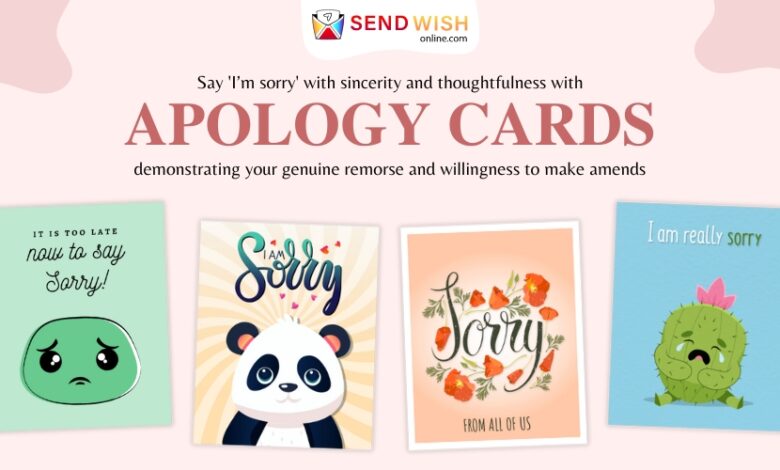Cards That Speak Louder Than Words: The Art of Apology Card

Some people say that apology is one of the things that are challenging to express, but it is also one of the most important. Regardless of whether it is due to a misunderstanding, a missed event, or a personal error, apology is very much needed. The way the same apology is pronounced is highly important. Words are not the essence, but how you convey them; it is about showing sincerity and effort to repair the relationship. Enter humble sorry card. This oft-overlooked medium can turn into an everyday apology something memorable, and if done right, indeed it speaks volumes. And in this article, we are going to explore how you can say sorry with style through cards that leave a lasting impact.
The Power of a Written Apology
With text messages and emails having taken over in this fast-paced world of today, an essential handwritten card can stand out from the crowd to show that this is indeed a person who has taken time out from their day to reflect over their actions, consider the feelings of the other party, and to compose an Apology card in words. This act alone can soften the heart and pave the way towards reconciliation.
Why are cards so powerful?
Personal touch: Writing a card is more personal than sending a quick message. Shows effort, thoughtfulness, and care.
Tangible: Unlike a text message that can be lost in a long thread, a card is a physical keepsake, something the recipient can hold on to, reminding them of your sincerity.
Timeless: A card is truly an act that stands above the ephemeral meaning of digital communication. There is something greater to it because it holds a sort of permanent feeling that gives it so much power.
Emotional depth: A written apology can be expressed in-depth in words, unlike a brief message where tone and emotion can often be misunderstood.
Choosing the Right Card: Matching Style to the Situation
Begin by selecting the appropriate card for the stylish and impactful apology. Apology cards come in all shapes, sizes, and designs, but picking one that suits the situation should be your aim. Here is how to go about it:
-
It must be simple and elegant
Sometimes, less is more. The simple, elegant design can show respect and sincerity. Cards that have minimalist designs, soft colors, and clear font styles are great. Extremely decorative cards may look too casual or too distracting, but a sleek card is really thoughtful and serious.
For use in: Apologies for serious issues or professional situations.
Examples: Something like a card with a soft neutral background and a single word saying “Sorry” is very striking, not overwhelming.
-
Inject a bit of humor
If the situation permits, a card with a dose of humor really is what can work. You show that you are not afraid to even admit your failure, and you lighten the mood to it, however you will easily keep things light. Of course, gauging if humor is appropriate is equally important. If the person is almost hurt, or if the matter at hand is quite serious, then the best way is to stick to something more solemn.
Use it: For a small mistake or for any other situation where you are sure the recipient would appreciate some humor.
Examples: A cartoonie card or playfully saying, “I’m sorry to be such a doughnut!” with an image of a giant grinning doughnut at the bottom; this will cheer up the recipient as she identifies the mistake.
-
Choose Emotional
For deeper, personal apologies – especially within relationships, a sentimental card is best to convey your deeper emotions. Use cards containing heart-warming quotes or meaningful illustrations or even blank cards where you can write your own message. It shows that not only do you care about the action but that you truly value the relationship.
When to use: In close, personal relationships – romantic partners, close friends, or family.
Example: One such card which has a touching quote like the following is: “I’m sorry for all that pain. Words cannot say how much I value our relationship,”
While creating the right apology message
Once you’ve chosen the perfect card, it’s time to focus on what really matters: the message. A fashionable card can only take you so far; it’s the words inside that carry the weight of a genuine apology. Here are some tips on how to pen a sincere message that will make your apology feel heartfelt.
-
Acknowledge Your Mistake
A proper apology begins with taking full accountability for your mistakes. Do not attempt to downplay the offense or sidestep responsibility. The person you are apologizing to must hear that you understand what you did wrong.
Example: “I know my words were hurtful to you, and I am completely responsible for that.”
-
Express Regret
Acknowledgement of your mistake
Show remorse, that you actually feel bad for your mistake.
Example: “I really am sorry for the way my actions have affected you, and it hurts me to know that I caused you pain.”
-
Explain your mistake. Don’t ever try to excuse it.
Explain briefly if there is context behind your actions but don’t make this an excuse. You are only being clear, not making an excuse for yourself.
Example: “I was under a lot of stress at the time, but I know that doesn’t justify my behavior.”
-
Commit to Change
Finally, a heartfelt apology also includes an intention to improve. This makes the other person understand that you’re doing everything necessary to avoid the same thing from happening in the future.
Example: “I promise to be more mindful of my words and actions moving forward, and I’ll do my best to make things right.”
-
End on a Positive Basis
End your message with a statement reminding them of your concern for the person and wishing them reconciliation. This might be a way to go out and stay open to healing, and this lets them know you aren’t taking it lightly and have serious thoughts about the relationship.
Example: “I hope we can move past this, and I am committed to making our relationship stronger.”
Personalizing the Card: Sentimental Details That Count
Want to raise the stakes with your pathetic card? Well, then add personal touches that show just how much effort you have made for the apology. Here are creative ways to make your card stand out.
-
Include a Handwritten Note
Even if your card already has a message printed on it, putting in a handwritten word will make it more personal. It signifies that you don’t really rely on just the card alone, but you are making an effort yourself as well.
-
Thoughtful Gift
Adding a card paired with a small, thoughtful gift will really make your apology go a long way. The gift is not necessarily expensive-it could be something that holds sentimental value or reminds them you have been paying attention to their tastes and preferences.
Examples: A box of their favorite chocolates, a book they have been wanting, or even a playlist of songs that remind you of your relationship.
-
DIY Card
If you can go the extra mile, do this: make a DIY card. This reflects a lot because you took your time and put in effort towards your apology.
Materials
Construction paper
Markers
Stickers
Any other crafting materials that you prefer.
Personalization Add inside jokes, doodles, or memories you have with this person to make it more personalized.
When and How to Deliver the Card
The time for delivering an apology card is everything. Too early and still not ready to have an ear for your apology. Too late, and they’ll consider that you just forget or don’t even care anymore. Here’s how to get the timing right.
-
Wait for the right moment
Allow the recipient to cool off, especially if the circumstances are emotional. Bringing the card along too soon may give an impression that one is hurrying to get away from the situation without giving it the thought it merits.
-
Hand it over in person
Whenever feasible, present the card personally. This makes your apology more personal and enables you to interact with the person face to face. Indeed, when handed over in person, when seeing the truthfulness in your eyes, the recipient may begin to believe your words.
-
Mail It for Surprise Apology
If the distance is one that cannot allow for an in-person delivery, it can surprise the recipient by mailing the card. Such a happening would be not at all expected and may catch the recipient off guard in such a good way; you’d leave them to reflect on your Sorry online in that private, thoughtful space.
Conclusion: Apologizing with Style and Grace
Sorry does not have to be a daunting task. Thus, with a proper card, an emotional message, and a thoughtful dispatch, an apology can become a meaningful related moment. After all, apology cards offer you the chance to express your regret in a sophisticated yet sincere manner showing this person how much you really care. Next time you want to apologize, do not just type it out in a hasty text but instead take the time to write out the card that speaks a thousand words. After all, it is the manner in which you apologize that makes all the difference.




